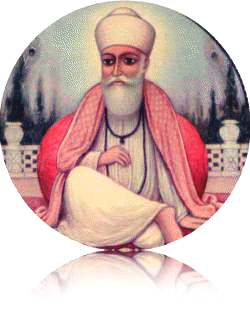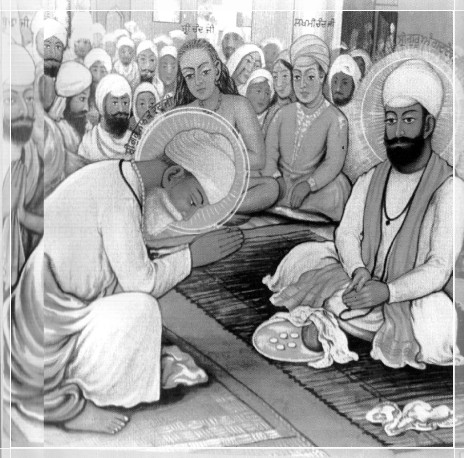namdhari world
Main menu:
- Home Page
- Kuka Faith
- History
- Sikh Gurus
- Namdhari Gurus
- Freedom Fighter - Satguru Ram Singh Ji
- Warrior of Peace
- Non-Cooperation Movement page 1
- Non-Cooperation Movment page 2
- Kuka Postal Service
- No Trial
- Battle for recognition as part of India's struggle for freedom
- Plaque at Ludhiana Railway Station
- Ram Singh Kuka by G.K.Venkateshamurthy
- Social Reforms by Satguru Ram Singh Ji
- Birth of Sant Khalsa
- Kuka Movement - by Film division of Government of India
- KUKA LEHAR - India's first war for independance (1856)
- Satguru Jagjit Singh Ji
- Contradictions
- Historical Quotes
- Vaisakhi - 1699
- Gurmukhi Script
- Sikh Women
- Knowlegde Bank
- Connections
- Places to visit
- Resources
- Music World
- Calendar
- Sports
- ETC...
Guru Nanak Dev Ji
History > Sikh Gurus
(1469-1539)
Avtar Or Parkash Diwas Vaisakh Sudi 3, 20th Vaisak 1526 Bikarmi
Date of Birth 30 November, 1469
Place of Birth Village Raiboide Tawandi (Pakistan) - Nankana Sahib
Gurgaddi Diwas From Birth
Joti Jot Diwas Asu Vadi 1596 Bikarmi (7 Sept 1539)
Father Shri Kalyan Dass Mehta Ji Mother Mata Taripta Ji
Wife/Wives Mata Sulakhni Ji
Children Baba Shri Chand Ji & Baba Shri Lakhshmi Dass Ji

The first of the Gurus and the founder of the Sikh religion was Guru Nanak. He was born in Rai Bhoi Di Talwandi now called Nankana Sahib.( In Pakistan), on 30 November 1469 AD. Guru Nanak's father was Shri Kalyan Dass Mehta Ji. He was a kathri by caste and the village accountant (Patwari) and his mother was Mata Taripta Ji . As a boy, he used to take the cattle to pasture. But he was devoting his solitude to inward communion. As a child Guru Nanak Dev Ji was extraordinary in many different ways, had a contemplative mind and rational thinking. The young Nanak was sent for tuition in Hindi to Pandit Gopal in 1475 AD ,for Sanskrit to Pandit Brij Lal in 1478 AD and for Persian to Maulvi Kutubdin in 1481 AD. He amazed his teachers with his sublime knowledge and by the age of 13 he had mastered Hindi, Sanskrit and Persian. Throughout his life even as an infant, Guru Nanak Dev Ji educated those around him, however people regarded him with suspicion as he was unconventional.
In 1484 AD Guru Nanak was sent to his sister Bibi Nanaki at Sultanpur Lodhi where he took up a job as storekeeper of Daulat Khan Lodhi. While in Sultanpur Lodhi Gur Nanak married and he had two sons - Shri Chand Ji and Shri Lakhshmi Dass Ji.
At the age of 38, in August 1507, Guru Nanak Dev Ji was bathing in a small river "Vain Nadi" near Sultanpur Lodhi when he heard God's call to dedicate himself to the service of humanity. Guru Nanak Dev Ji preached God's unique and divine doctrine through four long journeys visiting different religious places called "Char Udasis".
Guru Nanak Dev Ji went to Kurukshetra, Haridwar, Joshi Math, JAatiia Sahib, Gorakh Malta, Audliya, Prayag, Varanasi, Gaya, Patna, Dhubri and Gauhati in Assam, Dacca, Puri, Cuttock, Rameshwaram, Ceylon, Bidar, Baroach, Somnath, Dwarka, Janagarh, Ujjain, Ajmer, Mathura, Pakpattan, Talwandi, Lahore, Sultanpur, Bilaspur. Rawalsar, Jawalaji, Spiti Vally, Tibet, Ladakh, Kargil, Amarnath, Srinagar, Baramula, Syra, Turkey, Tehran, Kabul, Kandhur, Jalalabad, Mecca, Medina, Baghdad, Multan, Peshawar Sakhar, Son Miani, Hinglaj etc. The mission was to educate people to realise the truth about God.
This was the darkest period of India's history when the people were absolutely divided and demoralized. In addition, the priests had reduced religion to a mockery. The public was blind in its faith, and governed by superstitions. Seeing all this, Guru Nanak started building a nation of self-respecting men and women, devoted to God and their leaders, filled with a sense of equality and brotherhood.
In 1522 did Guru Nanak Dev Ji settle down at Kartarpur which was where he spent the rest of his life. Guru Nanak Dev Ji had laid down the foundations of Sikhism.
As a social reformer Guru Nanak Dev Ji upheld many causes, helping the poor, the outcasts, the down trodden and championed equality for women. He composed 947 hymns including JapiJi Sahib, Asa Di Waar, Bara Maha and Sidb Ghost.
Guru Nanak Dev Ji established the institution of Langar. Accompanied by Bhai Mardana, various ragas were composed. Not only a reformer but also a revolutionary, Guru Nanak Dev Ji helped countless souls to see the error of their ways.
Guru Nanak invented the Gurmukhi script in the form of "Gurmukhi Painti". At the time of Guru Nanak, Punjab had no set language. There were different dialects and scripts, e.g. Sharda Takri (Thakri), Persian and Bhatt Akhri, etc. The 52-letter script was a mixture of several languages.
Guru Nanak Dev ji observed that there were many superfluous letters in that script so he composed Patti, which depicted only 35 letters. He even gave the pronunciation of each letter. He asked Bhai Lehna (Guru Angad Dev Ji) to put all the letters in an alphabet form and in a proper order. Bhai Lehna who was a scholar, and poet, and was also fully conversant with all these scripts readily agreed to accomplish the task. He prepared the alphabet and put the same to his Master who gave his approval. As Bhai Lehna devised the script, the same is known as Gurmukhi - a language devised by a Gurmukh at the instance of the Guru. This script was adopted by all the composers of Bani and in the same very script was written Aad Sri Guru Granth Sahib. The language enshrined in this script came to be known as Punjabi and is being treated as the language of Punjab. With the passage of time it has spread to all the corners of the world and is universally acclaimed as a very rich and developed language.
Nearing the end of his days, Guru Nanalc Dev Ji devised a number of tests for his sons and other loyal followers. Out of all of them, Bhai Lehna Ji was installed as the next Guru (thus starting the marayada of Dehidari Gurus) Bhai Lehna Ji was renamed as Guru Angad Dev Ji.
There was not a single aspect of earthly or spiritual life which was not enlightened by Guru Nanak. He passed away on 7 September 1539.

Guru Nanak Dev Ji initiated the maryada of 'The Deghdhari Guru' by passing the Gurgaddi to Guru Angad Dev Ji.
GURU NANAK DEV AND HIS TEACHINGS
Guru Nanak, the founder of the sikh religion was born to the Bedi family in Nankana Sahib, Punjab, in the year 1469. At the ti me of his birth, an astrologer worshipped him with folded hands after meeting him.
At the young age of five, Nanak began discussing on spiritual subjects even his teacher could not utter a single word and abashed before the divine master and bowed to him when he asked him to cxplai n the meaning of the letters of the alphabet. N anak wrote the meaning of each and every letter of the alphabet. This was the first divine message delivered by him. This was an explanation of deeper truth about human beings and God and the way to realise God.
At the age of thirty, he suddenly disapperared. He came back after three days from the place where he used to take bath. He started teaching people. "There is no Hindu. There is no Muslim. There is only one God". This laid the foundation for the beginning of Sikhism. He listened to the people of all faiths and cultures. He travelled widely to famed and acclaimed seats of learning of those times in all the directions.
In the beginning, his teachings were not so popular I and acceptable to all. Guru Nanak evolved a new path to reach the God and that too with lot of practicabilities shown by himself through his visits. The beliefs and philosophies of this great guru are now ruling the lives of millions of people all around the world.
All the teachings of Guru Nanak can be confined to three main teachings: Naam Simran, Kirat Karo, Wand Chhako.
NAAM SIMRAN means remembering God and to practise it daily in the form of meditation which helps us keep our mind and body healthy.
KIRAT KARO preaches people to lead a normal life by earning their living through hard work, honesty without self interest, cheating and exploitation. He emphasised on dignity of labour.
WAND CHHAKO means sharing whatever you have with poor and needy people. Through this, Guru Nanak gave the message of brotherhood which is highly desirable in the present times.
All the above important teachings of Guru Nanak are very popular and relevant in the modern world.
Article by:
Principal Satwant Kaur
Shaheed Bishan Singh School
Guru Nanak Dev Ji / Guru Angand Dev Ji / Shri Guru Amardas Ji / Shri Guru Ramdas Ji / Shri Guru Arjan Dev Ji / Shri Guru Hargobind Sahib Ji / Shri Guru Har Rai Ji
Shri Guru Har Krishan Ji / Shri Guru Tegh Bahadur Ji / Sri Guru Gobind Singh Ji / Sri Guru Balak Singh Ji / Sri Guru Ram Singh Ji / Sri Guru Hari Singh Ji
Sri Guru Partap Singh Ji / Sri Guru Jagjit Singh Ji